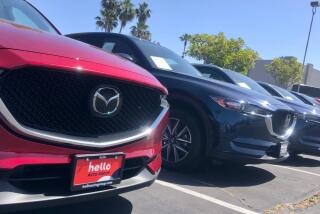GM Revs Up Its ’07 Vehicle Warranty
- Share via
General Motors Corp. announced Wednesday that it would improve the warranty on its 2007 model year cars and trucks, hoping to stop car buyers from migrating to Asian automakers.
GM extended its warranty to five years or 100,000 miles, substantially enhancing the three-year, 36,000-mile coverage the company had offered on engines, transmissions and other powertrain parts.
The plan, unveiled Wednesday by Chief Executive Rick Wagoner, is part of GM’s effort to stop being seen as a carmaker that depends on cash incentives and cheap interest rates to sell cars and trucks. The Detroit-based automaker has been losing market share to Asian rivals for more than a decade; its U.S. market share is at an 80-year low.
One analyst said the move was risky if GM failed to keep improving the quality of its vehicles. Increased repair bills and negative public perception would result if the company launches vehicles that cannot keep pace with rivals, said Chance Parker, head of product research for Westlake Village-based J.D. Power & Associates.
Most studies show that car shoppers believe vehicles from Toyota Motor Corp. and other Japanese brands are far more reliable than vehicles from U.S. carmakers. But analysts say the quality gap has been closing in recent years.
“In the short term, this will get people into GM vehicles who otherwise might have felt the quality and durability wasn’t there,” said Alexander Edwards, head of automotive market research for San Diego-based Strategic Vision. “And if GM can show that the quality is there with these and future vehicles, then this will be a very positive move for them.”
The warranty, which will be honored on 2007 models sold before the announcement, isn’t as generous as the 10-year, 100,000-mile coverage offered by Korean-owned Hyundai Motor Corp. and its Kia Motors Co. affiliate.
The extended warranty program “is about regaining customer confidence in our company and its products,” said Susan Docherty, general manager of GM’s Western Region.
GM’s overall quality has improved in recent years, J.D. Power’s Parker said. “But this is still a bit of a gamble. GM will have to continue improving its quality but at a faster rate than the industry norm, which they haven’t been able to do.”
One potential stumbling block, Parker said, “is consistency. They have some brands and models that do very well in our initial quality and dependability studies, and some that do not.”
In J.D. Power’s most recent reliability survey of vehicles that had been on the road for three years, GM’s Buick and Cadillac brands did better than the industry average, but its Pontiac, GMC, Chevrolet and Hummer brands fared worse. Four GM models topped their categories for durability, versus eight for Toyota.
Hyundai startled the industry in 1998 when it introduced the first 100,000-mile powertrain warranty. The company took that step to reinforce its claims of improved quality. The move helped boost its U.S. sales and changed car buyers’ negative perceptions of its vehicles.
Several Hyundai models have placed at or near the top of various quality studies in the last two years. Surveys now show that buyers generally believe the company makes quality cars and sport utility vehicles, said Edwards of Strategic Vision.
Executives at Hyundai said the extended warranty would show prospective buyers that the company was confident in the quality of its cars and would back its confidence with a long-term guaranty.
GM general manager Docherty said that was exactly what the company was doing.
GM also extended its roadside assistance and loaner car programs to match the longer term of the powertrain warranty.
Ford Motor Co. offers a five-year, 60,000-mile powertrain warranty for its 2007 Ford and Mercury models and covers Lincoln models for six years or 70,000 miles. Toyota provides a six-year, 60,000-mile powertrain warranty and Honda Motor Co. covers its Honda model powertrains for five years or 60,000 miles and its Acura models for six years or 70,000 miles.
Shares of GM rose 73 cents, or 2.4%, to $31.17.
*
More to Read
Inside the business of entertainment
The Wide Shot brings you news, analysis and insights on everything from streaming wars to production — and what it all means for the future.
You may occasionally receive promotional content from the Los Angeles Times.










